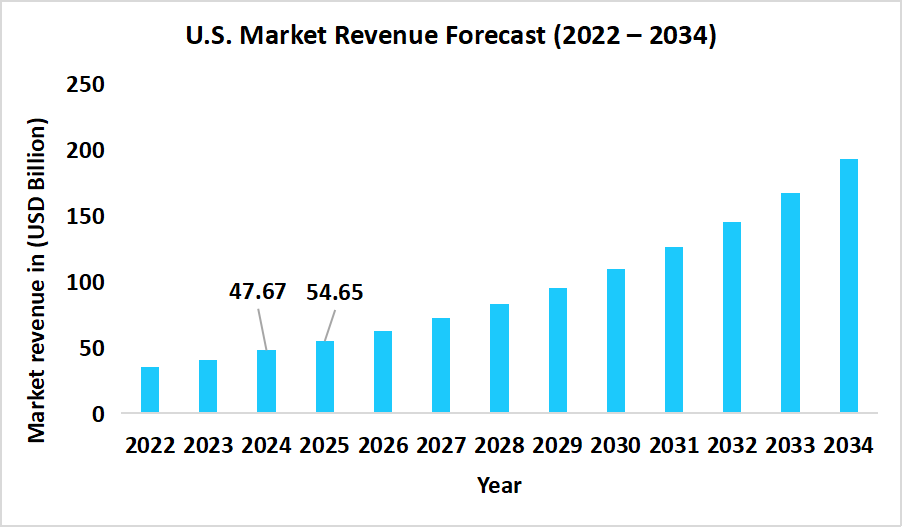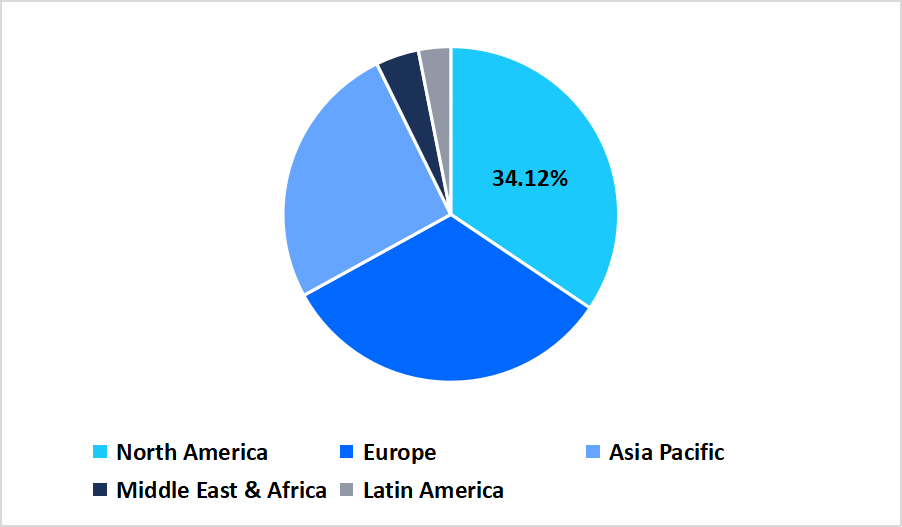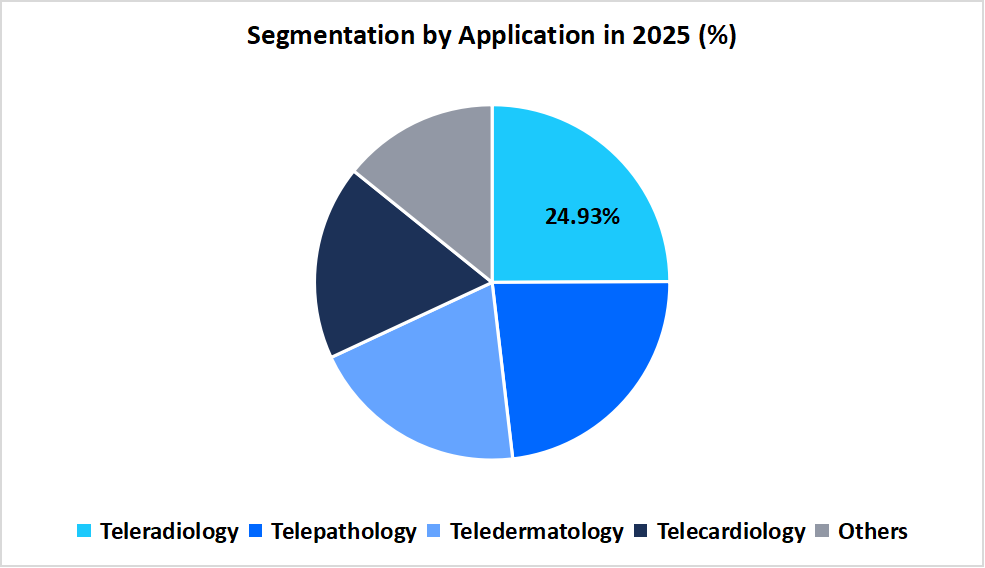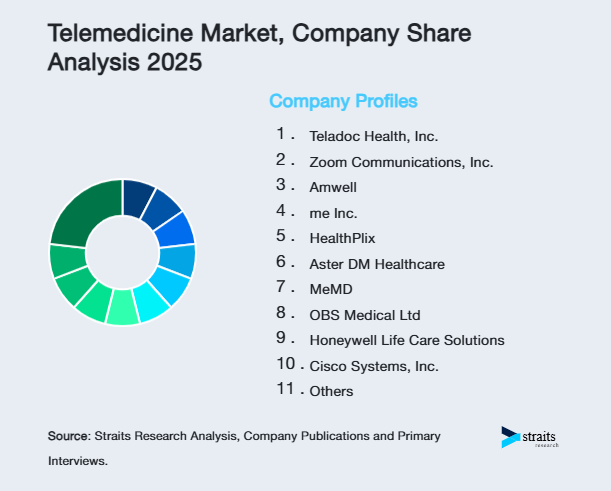Telemedicine Market Overview
The global telemedicine market size is estimated at USD 169.20 billion in 2025 and is projected to reach USD 596.08 billion by 2034, growing at a CAGR of 15.06% during the forecast period. Remarkable growth of the market is due to the surging adoption of digital healthcare delivery models, expanding reimbursement flexibilities, and the growing elderly population, which is increasingly dependent on virtual care services.
Key Market Trends & Insights
- North America held a dominant share of the global market, accounting for 12% share in 2025.
- The Asia Pacific region is growing at the fastest pace, with a CAGR of 17.01%.
- By Type, the service segment is expected to grow at a CAGR of 17.11%.
- By Application, teleradiology held the highest market share of 24.93% in 2025.
- By Modality, the real-time segment is expected to grow at a CAGR of 16.43%.
- By End User, providers dominated the market in 2025 with a market share of 31.5%.
- The U.S. dominates the global market, valued at USD 47.67 billion in 2024 and reaching USD 54.65 billion in 2025.
Graph: U.S. Market Revenue Forecast (2022 – 2034)

Source: Straits Research
Market Size & Forecast
- 2025 Market Size: USD 169.20 billion
- 2034 Projected Market Size: USD 596.08 billion
- CAGR (2025 to 2034): 15.06%
- Dominating Region: North America
- Fastest-Growing Region: Asia Pacific
The global telemedicine market encompasses a broad range of technologies and services designed to deliver healthcare remotely through digital platforms, improving accessibility, efficiency, and patient outcomes. By type, it includes products such as hardware, software, and others, along with services, where software and service components hold a share due to the growing demand for teleconsultation platforms, remote monitoring tools, and integrated virtual care systems. By application, the market spans teleradiology, telepathology, teledermatology, telecardiology, and others, with teleradiology leading the segment owing to its widespread adoption in diagnostic imaging and cross-specialty consultations. By modality, telemedicine operates through store-and-forward, real-time, and other modes, where real-time communication is growing due to advancements in broadband connectivity, secure video conferencing, and increased patient preference for live consultations. By end user, the market is segmented into providers, payers, patients, and others; healthcare providers are the major users as telemedicine becomes a key component of clinical workflows, while payers increasingly support virtual care reimbursement, and patients benefit from on-demand access to remote healthcare services.
Latest Market Trends
Legislative Focus on Balancing Costs and Sustained Access
Policymakers are trying to manage rising Medicare costs while keeping telehealth widely available. According to the American Medical Association 2024, extending Medicare’s telehealth flexibilities was expected to add over USD 2 billion in spending, so lawmakers had proposed a two-year extension to December 2026, along with reforms such as pharmacy benefit manager transparency and adjusted payment models. This approach showed how telehealth was becoming a permanent part of U.S. healthcare policy, ensuring access while addressing budget pressures.
Telehealth as a Prime Access Vector for Underserved and Disabled Patients
The reliance of undeserved and disabled patients on telehealth acts as a market trend as these groups use virtual care to overcome barriers, such as limited mobility, geographic isolation, and unequal access to in-person healthcare, therefore reinforcing telehealth's role in improving the services in healthcare delivery services. Government-backed analyses depicted that nearly 1 in 4 Medicare beneficiaries with disabilities used telehealth, with particular utilization rates among the Asian/Pacific Islander, Hispanic, and Black communities.
Such a factor highlighted the role of telemedicine in bridging the healthcare access gaps for vulnerable groups, which further contributed to the overall market growth.

To get more insights about this report Download Free Sample Report
Telemedicine Market Drivers
Policy Incentives and Reimbursement Expansion
Government policies and reimbursement support play an essential role in enhancing the adoption of telemedicine, which further drives the market growth. For example, the Telehealth Modernization Act of 2024 extended the Medicare coverage for telemedicine visits, which ensured that patients can continue accessing the virtual care in the long term.
Such measures encouraged patients to keep using the virtual care and also provided financial stability by reducing cost barriers, which further strengthens the overall telemedicine market.
Market Restraint
Regulatory Uncertainty of Telemedicine
Regulatory uncertainty hinders the market growth as the impending expiry of pandemic-era telehealth flexibilities develops hesitation among the providers and also the insurance company to commit towards the long-term investments. For instance, the key U.S. telehealth flexibilities, such as relaxed geographic restrictions and waived in-person requirements were expired on 30th September, 2025, potentially reinstating pre-pandemic limitations.
Such uncertainty threatened to limit patient accessibility and also slowed the sustained expansion of the telemedicine services.
Market Opportunities
AI-Powered Telemedicine Acceleration
AI is emerging as a major enabler for telemedicine, which further presents as a market opportunity as it enhances the diagnostic precision, scalability as well and personalization of care. The integration of predictive analytics, AI chatbots as well as remote monitoring systems enabled faster triage, efficient physician support, which also enhanced patient engagement across the virtual platforms.
These factors present an opportunity for telemedicine providers as the adoption of AI expands service capabilities, easing the clinical workload, which further supports meeting the growing patient demand.
Regional Analysis
The North America region dominated the market with a revenue share of 34.12% in 2025. The growth is attributed to factors such as advanced digital infrastructure, which enables seamless integration of innovative technologies, supports faster adoption of digital solutions across industries, which further enhances connectivity for businesses and consumers.
The telemedicine market in U.S. is widely driven by the supportive healthcare policies. For instance, in March 2025, the U.S. Congress passed a continuing resolution, which is signed by President Trump, regarding the extension of the telehealth benefits for the Medicare beneficiaries for an additional six months. This extension included various provisions, such as removing the geographic restrictions, expanding the eligible practitioners, and permitting the audio-only telehealth services.
Asia Pacific Market Insights
The Asia Pacific region is the fastest-growing region with a CAGR of 17.01% during the forecast timeframe, owing to a large patient population and growing healthcare needs, which enhances the rapid increase in the demand for accessible and efficient healthcare solutions.
India continues to position itself in the telemedicine market due to the government's expansion of new telemedicine clinic facilities across the country. For instance, in January 2025, the Government of India collaborated with the Aster Volunteers and launched two IoT-enabled Mobile Medical Clinics equipped with telemedicine services, mini labs, consultation areas, and health education programs, which hence propels the market growth.
Pie Chart: Regional Market Share, 2025

Source: Straits Research
Europe Market Insights
The key driver in the European market is the widespread integration of cross-border telehealth platforms that enable collaboration among healthcare providers across different European countries, enhancing access to specialized care.
In Germany, the telemedicine sector is driven by the digital healthcare act which enables reimbursement of the digital health apps as well as telehealth, the nationwide rollout of the electronic patient records which is integrated with the secure telematics infrastructure, potent investment in the health-tech startups and the diverse provider as well as patient adoption of video consultations and remote monitoring, which is supported by the government funding and regulatory modernization.
Middle East and Africa Market Insights
In the Middle East and Africa, telemedicine platforms are increasingly offering services in local languages to cater to the diverse linguistic needs of the population. Platforms such as Altibbi provide healthcare consultations in Arabic, while others support French, Swahili, and regional dialects across the continent. This localization improves accessibility, enhances patient engagement, and builds trust in digital healthcare solutions, particularly in regions where language barriers have historically limited access to quality medical care.
In South Africa, government support for telemedicine is a key driver of market growth. The implementation of the National Health Insurance (NHI) Bill in 2023 emphasizes the integration of digital health and telemedicine solutions into the national healthcare strategy, aiming to improve accessibility and affordability of medical services across the country. This policy initiative encourages healthcare providers to adopt telemedicine platforms, expand remote care services, and bridge gaps in healthcare delivery, particularly in rural and underserved regions.
Latin America Market Insights
In Latin America, the region’s vibrant startup ecosystem is driving innovation in telemedicine, with numerous local companies developing digital health solutions tailored to the unique healthcare needs of the population. These startups are introducing platforms for remote consultations, mobile health applications, AI-driven diagnostics, and telemonitoring services, supporting to expand of access to care, improving patient outcomes, and accelerating the overall growth of the market across the region.
In Argentina, the market is experiencing rapid growth, largely driven by initiatives aimed at expanding connectivity in rural and remote areas. These programs have made it possible for residents in regions with limited access to traditional healthcare facilities to consult doctors virtually, receive diagnoses, and manage chronic conditions without traveling long distances. For example, in Patagonia, teleconsultation programs allow patients in remote towns to connect with specialists in urban centers, facilitating timely medical advice, reducing healthcare disparities, and improving overall health outcomes. Such initiatives not only increase access to essential healthcare services but also promote the adoption of digital health technologies across the country.
Type Insights
The service segment is anticipated to grow at a CAGR of 17.11% from 2026 to 2034. The growth is attributed to the rising demand for remote consultations, chronic disease management programs, and post-operative monitoring delivered via virtual platforms.
The products segment dominated the market in 2025, due to the increasing adoption of advanced telemedicine hardware and software solutions that enable seamless virtual consultations, remote patient monitoring, and real-time data sharing
Application Insights
The teleradiology segment dominated the market with a revenue share of 24.93% in 2025. This growth is attributed to rising global demand for remote diagnostic imaging, which is driven by the shortage of radiologists, increasing imaging volumes as well as the growing need for 24*7 radiology reporting. Further, the advancements in digital imaging technologies have further accelerated the adoption by improving both the diagnostic accuracy as well as turnaround times.
The tele dermatology is anticipated to register the fastest CAGR of 17.58% during the forecast period. The segment is growing due to the increasing prevalence of skin disorders, rising demand for remote dermatological consultations, and the shortage of dermatologists in several regions.

Source: Straits Research
Modality Insights
The real-time segment is anticipated to register the fastest CAGR of 16.43% during the forecast period. The growth is attributed to the increasing preference for live, interactive consultations between the patients and the healthcare providers, which ensures timely diagnosis, treatment, and follow-up care. Further, the advancements in video conferencing technologies, widespread smartphone penetration, and the expansion of high-speed internet infrastructure further support seamless virtual interactions.
The store and forward segment dominated the market, with a revenue share of 49.32%, owing to its ability to facilitate efficient data exchange and diagnosis without the need for simultaneous communication between patients and healthcare providers.
End User Insights
Providers segment dominated the market in 2025 with a market share of 31.5%, owing to the efficient, cost-efficient as well as scalable solutions for the delivery of remote care. Healthcare providers also extend their reach, offer consultations, monitoring as well as follow-up care to their patients regardless of the location. Moreover, providers increasingly rely on telemedicine to enhance their service delivery, which further enhances the segment growth.
The patients segment is anticipated to register the fastest CAGR of 17.11%, due to the increasing prevalence of lifestyle-related and chronic diseases that require continuous monitoring and follow-up care, which telemedicine makes more manageable.
Competitive Landscape
The global telemedicine market is moderately fragmented in nature due to the regional regulatory environments, varying levels of technological integration, and also due to the presence of numerous low as well as medium-sized companies offering a diverse range of services. The top players are Teladoc Health, Inc., Zoom Communications, Inc., Amwell,and Doxy. Me Inc., HealthPlix, Aster DM Healthcare, MeMD, OBS Medical Ltd, Honeywell Life Care Solutions, Cisco Systems, Inc and Others.
Teladoc Health, Inc.: An emerging market player
Teladoc Health, Inc. is a company that delivers complete and personalized care across patients, care providers, platforms, and partners via their technologies, services as well and clinical expertise.
- In February 2025, Teladoc Health acquired Catapult Health for USD 65 million to strengthen its preventive and chronic care services through at-home virtual screenings and consultations.
List of key players in Telemedicine Market
- Teladoc Health, Inc.
- Zoom Communications, Inc.
- Amwell
- me Inc.
- HealthPlix
- Aster DM Healthcare
- MeMD
- OBS Medical Ltd
- Honeywell Life Care Solutions
- Cisco Systems, Inc.
- Medtronic
- AMD Global Telemedicine
- Allscripts
- GlobalMed Holdings
- HealthTap, Inc.
- Honeywell International Inc.
- Koninklijke Philips N.V.
- Cisco Systems, Inc.
- GE HealthCare
- AMD Global Telemedicine
- Others

To get more findings about this report Download Market Share
Strategic Initiatives
- September 2025: Comitas e-Health installed its Mobile Telemedicine Unit for the third consecutive year at the La Vuelta by providing on site digital X-ray services across all 21 stages to enhance rider care and also to reduce hospital transfers.
- September 2025: FWD Life Insurance in Thailand expanded its FWD Telemedicine services by introducing the MorDee app, which enabled customers to access real-time, cashless online doctor consultations using the outpatient insurance benefits instantly.
- June 2024: Infosys partnered up with Nihon Chouzai in Japan for enhancing its telemedicine services via the NiCOMS mobile app, which enabled patients to receive remote medication guidance from the registered pharmacist, hence eliminating the need for in-person visits.
- May 2024: Apollo TeleHealth's ISO certification from the British Standards Institution positioned a global benchmark for quality as well as risk management in telemedicine services, which further emphasized the importance of standardized practices to boost trust, reliability, and market growth.
Report Scope
| Report Metric | Details |
|---|---|
| Market Size in 2025 | USD 169.20 Billion |
| Market Size in 2026 | USD 194.07 Billion |
| Market Size in 2034 | USD 596.08 Billion |
| CAGR | 15.06% (2026-2034) |
| Base Year for Estimation | 2025 |
| Historical Data | 2022-2024 |
| Forecast Period | 2026-2034 |
| Report Coverage | Revenue Forecast, Competitive Landscape, Growth Factors, Environment & Regulatory Landscape and Trends |
| Segments Covered | By Type, By Application, By Modality, By End User, By Region. |
| Geographies Covered | North America, Europe, APAC, Middle East and Africa, LATAM, |
| Countries Covered | U.S., Canada, U.K., Germany, France, Spain, Italy, Russia, Nordic, Benelux, China, Korea, Japan, India, Australia, Taiwan, South East Asia, UAE, Turkey, Saudi Arabia, South Africa, Egypt, Nigeria, Brazil, Mexico, Argentina, Chile, Colombia, |
Explore more data points, trends and opportunities Download Free Sample Report
Telemedicine Market Segmentations
By Type (2022-2034)
-
Products
- Hardware
- Software
- Others
- Services
By Application (2022-2034)
- Teleradiology
- Telepathology
- Tele dermatology
- Telecardiology
- Others
By Modality (2022-2034)
- Store and forward
- Real Time
- Others
By End User (2022-2034)
- Providers
- Payers
- Patients
- Others
By Region (2022-2034)
- North America
- Europe
- APAC
- Middle East and Africa
- LATAM
Frequently Asked Questions (FAQs)
Debashree Bora
Healthcare Lead
Debashree Bora is a Healthcare Lead with over 7 years of industry experience, specializing in Healthcare IT. She provides comprehensive market insights on digital health, electronic medical records, telehealth, and healthcare analytics. Debashree’s research supports organizations in adopting technology-driven healthcare solutions, improving patient care, and achieving operational efficiency in a rapidly transforming healthcare ecosystem.
Speak To AnalystAvailable for purchase with detailed segment data, forecasts, and regional insights.
Get This ReportOur Clients:










































